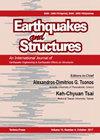Lateral-torsional seismic behaviour of plan unsymmetric buildings
IF 1.1
4区 工程技术
Q3 ENGINEERING, CIVIL
引用次数: 0
Abstract
Torsional response of buildings is attributed to poor structural configurations in plan, which arises due to two factors – torsional eccentricity and torsional flexibility. Usually, building codes address effects due to the former. This study examines both of these effects. Buildings with torsional eccentricity (e.g., those with large eccentricity) and with torsional flexibility (those with torsional mode as a fundamental mode) demand large deformations of vertical elements resisting lateral loads, especially those along the building perimeter in plan. Lateral-torsional responses are studied of unsymmetrical buildings through elastic and inelastic analyses using idealised single-storey building models (with two degrees of freedom). Displacement demands on vertical elements distributed in plan are non-uniform and sensitive to characteristics of both structure and earthquake ground motion. Limits are proposed to mitigate lateral-torsional effects, which guides in proportioning vertical elements and restricts amplification of lateral displacement in them and to avoid torsional mode as the first mode. Nonlinear static and dynamic analyses of multi-storey buildings are used to validate the limits proposed.平面非对称建筑的侧向扭转地震性能
建筑物的扭转响应归因于平面图中的不良结构配置,这是由两个因素引起的——扭转偏心率和扭转柔性。通常,建筑规范会解决由于前者而产生的影响。这项研究考察了这两种影响。具有扭转偏心率的建筑物(例如,具有大偏心率的建筑)和具有扭转柔性的建筑物(以扭转模式为基本模式的建筑)要求抵抗横向载荷的垂直元件发生大变形,尤其是沿平面建筑周边的垂直元件。采用理想化的单层建筑模型(具有两个自由度),通过弹性和非弹性分析,研究了不对称建筑的横向扭转响应。平面分布的竖向单元的位移要求是不均匀的,对结构和地震动特性都很敏感。提出限值是为了减轻横向扭转效应,该效应指导垂直元件的比例,并限制其中横向位移的放大,并避免将扭转模式作为第一模式。多层建筑的非线性静态和动态分析用于验证所提出的极限。
本文章由计算机程序翻译,如有差异,请以英文原文为准。
求助全文
约1分钟内获得全文
求助全文
来源期刊

Earthquakes and Structures
ENGINEERING, CIVIL-ENGINEERING, GEOLOGICAL
CiteScore
2.90
自引率
20.00%
发文量
0
审稿时长
>12 weeks
期刊介绍:
The Earthquakes and Structures, An International Journal, focuses on the effects of earthquakes on civil engineering structures. The journal will serve as a powerful repository of technical information and will provide a highimpact publication platform for the global community of researchers in the traditional, as well as emerging, subdisciplines of the broader earthquake engineering field. Specifically, some of the major topics covered by the Journal include: .. characterization of strong ground motions, .. quantification of earthquake demand and structural capacity, .. design of earthquake resistant structures and foundations, .. experimental and computational methods, .. seismic regulations and building codes, .. seismic hazard assessment, .. seismic risk mitigation, .. site effects and soil-structure interaction, .. assessment, repair and strengthening of existing structures, including historic structures and monuments, and .. emerging technologies including passive control technologies, structural monitoring systems, and cyberinfrastructure tools for seismic data management, experimental applications, early warning and response
 求助内容:
求助内容: 应助结果提醒方式:
应助结果提醒方式:


